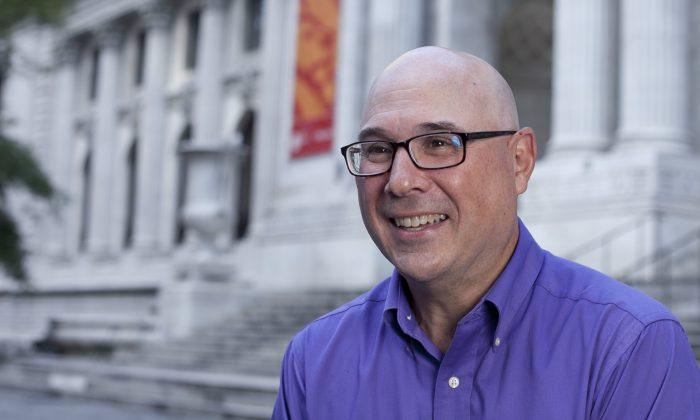NEW YORK—Bordering both sides of the New York Public Library building on Fifth Avenue, stand two flag poles that are often invisible when one stares at the library’s Beaux-Arts architecture.
But Michael Miscione sees them differently. The flagpoles are reminiscent of a forgotten New York City story.
“I think that’s one of the coolest things in the world,” said Miscione, the Manhattan Borough historian.
“The reason I love it is not for the beauty, which is unmistakable, but because these two flag poles are monuments to John Purroy Mitchel,” he said.
On the left of the building, an American flag remembers Mitchell the fallen serviceman, while on the right, the New York City flag commemorates Mitchel the former mayor.
Mitchel, only 34 when elected, served as New York City mayor from 1914–1917 and was known as a reformer. After losing his re-election, he left the city to fight in the remainder of World War I.
But before he got to the war, Mitchel met his tragic end when he forgot to strap his seat belt on while flying an aircraft upside down during training.
“Yeah, it’s sad,” Miscione said. “But he’s largely forgotten. And he was a really good mayor who did a lot of good things.
“The history of the city is so rich. There is so much to discover that it would just take forever,” Miscione said. “And it’s not my job to do that, it’s the people’s job to do that on their own.”
Miscione works full time at the Intrepid Museum, where his two loves collide.
“The Intrepid is very historical. But people also ask how a big steel ship can float. One of my jobs is to explain that to people—and I can explain it,” he said.
“[This is a] ship that has been through two wars, not to mention the Cold War in between, and a space race. Plus we have submarine,” Miscione said. “No one realizes we have a real submarine. It’s a cold war era submarine.”
Self Sufficient
Miscione, 54, is a man who has always taken initiative. He is probably still as sprightly as he was as a teenager. He speaks intelligently, but with fervor and at a rapid pace.
In the ’70s he was one of the few bold people who traversed the East Coast by bike.
“Today, it is much more common and accepted,” he said. “Back then people found the whole idea of bicycling hundreds of miles in these backwoods places just mind-boggling.”
The two longest rides he ever did were from New York to Florida, and another one from New York to Tennessee.
“You’re in your own little contained home, and you’re seeing the country at a reasonable price,” Miscione said. “It’s an amazing feeling.”
He slept in a tent and cooked his own food.
“You get a very strong sense of self reliance when everything you are carrying is everything you need to survive on your trip.”
Not surprising, Miscione prefers to read nonfiction. The last fiction work he read was Moby Dick a year and a half ago.
“I enjoyed it. It was a slog. It’s not a terribly easy read,” he said. “But it was historic and technical so that interested me. All the things about the hooks and stripping the whale of its blubber, it’s interesting stuff.”
Graphic Designer, TV Producer, Historian
Miscione grew up in Bensonhurst, Brooklyn. As a child, he dreamed of becoming a chemist.
“I loved the orderliness of [chemistry], the mysteriousness of it. It’s an interesting, largely unseen world,” he said. “It’s magic to me.”
Yet somehow, Miscione got involved in graphic design and studied communications during his college years at Baruch. Freelance T-shirt designing was one of the jobs that got him through college.
“I’ve walked a wandering, meandering path,” he said.
Before becoming the official Manhattan Borough historian, Miscione was a TV producer for the city’s cable television network.
“I produced government hearings, the mayor’s radio show, C-Span-y stuff,” he said.
“I knew a little bit about history. I knew that in 1898 Brooklyn, which used to be a city, was annexed with what we now call the other four boroughs to create the New York City that exists today,” he said. “But I really didn’t know how that happened.”
Neither did many others.
So Miscione jumped into producing a documentary about the consolidation of Greater New York.
“For nine months ... I ate, drank, and slept in the consolidation of the greater New York,” he joked. “I learned amazing things that most people never knew, that a lot of historians never knew either.”
Through research and interviews, Miscione discovered that it was Andrew Green, a city planner and historic preservationist, who played a large role in the consolidation of Greater New York, as well as the creation of iconic New York sites such as Central Park, the Metropolitan Museum of Art, and the New York Public Library.
Yet a few years ago there had been nothing but a bench set up in Central Park to remember Green.
In 2010, Miscione got the city to approve the creation of a park in honor of Green. The Upper East Side Park was slated to be completed in 2012, but it is still under construction.
During the process of fighting for Green’s recognition today, Miscione said the idea hit him that he would really like to be the Manhattan Borough historian one day. The borough historian is an unpaid role, and the appointee is expected to give speeches, field questions from the media, individuals, and public institutions.
Chasing Stringer
On an ordinary day eight years ago, Miscione was returning to his Midtown home after grocery shopping.
He passed his neighborhood synagogue, where city council and borough president candidates happened to be holding a debate.
“It occurred to me that we were getting a new borough president and he picks the new borough historian,” he said.
Miscione said it seemed obvious to him that Stringer was going to win, so he introduced himself as a great Manhattan historian candidate.
“He went about his business and I’m sure he probably forgot all about me,” Miscione said.
After Stringer won, Miscione submitted a resume and videotape. “I followed it up and followed it up and eventually they got around to choosing a new borough historian and chose me,” he said.
“It was a lark, I just stumbled into that event,” Miscione said.
His appetite for news as a child has served him well.
“I was always aware of what was going on in my city as I was growing up,” he said. “That knowledge and background and context has served me well to this day. When people talk about the fiscal crisis in the ’70s, I know all about that. I lived through that. I remember what the subways were like; I remember how dilapidated the parks were.”
“People need to be more aware of what’s going on around them. History is being made everyday,” Miscione said.





